Difference between revisions of "Carving leather"
| Line 14: | Line 14: | ||
Carving is a traditional method of [[[[leather workshop|leatherworking]] used to decorate leather articles. By means of carving tools (metal stamps cast into certain shapes), lines, grooves and patterns such as monograms or coats of arms are pressed, stamped and punched into the leather. Carving tools are available in many variations, shapes and sizes. Even carving tools with leaf shapes and embellishments are offered. | Carving is a traditional method of [[[[leather workshop|leatherworking]] used to decorate leather articles. By means of carving tools (metal stamps cast into certain shapes), lines, grooves and patterns such as monograms or coats of arms are pressed, stamped and punched into the leather. Carving tools are available in many variations, shapes and sizes. Even carving tools with leaf shapes and embellishments are offered. | ||
| − | Best for carving is [[Thickness of leather|thick]], [[Leather grain - Grain side|fine grained]], [[Vegetable-tanned leather]] without [[finish| | + | Best for carving is [[Thickness of leather|thick]], [[Leather grain - Grain side|fine grained]], [[Vegetable-tanned leather]] without [[finish|binder based finish]]. Such leather has the necessary stability for processing and the motifs result best. The motives are hammered with a hammer firmly on the previously with a sponge or cloth moistened leather. This is re-done at a different location and the process is repeated until the complete desired pattern is finished. A great expenditure of force is not necessary. Due to the moistening, the leather fibre is swollen and deforms easy and remains stable after drying. |
Basically, this work is very easy. But as with all the arts, there are people who have a talent to "paint" motifs on leather. | Basically, this work is very easy. But as with all the arts, there are people who have a talent to "paint" motifs on leather. | ||
| Line 67: | Line 67: | ||
</p> | </p> | ||
<p align=center> | <p align=center> | ||
| − | ''Extraordinary fine work from the [[leather workshop]] of | + | ''Extraordinary fine work from the [[leather workshop]] of [https://www.facebook.com/sele.selestudio?fref=ts Selestudio].''<br></p> |
<p> </p> | <p> </p> | ||
| Line 109: | Line 109: | ||
</p> | </p> | ||
<p align=center> | <p align=center> | ||
| − | ''Carved [[leather book covers]] of [https://www.facebook.com/pages/DragosMan/225352284254673?fref=ts DragosMan].''<br></p> | + | ''Carved [[Leather book cover|leather book covers]] of [https://www.facebook.com/pages/DragosMan/225352284254673?fref=ts DragosMan].''<br></p> |
<p> </p> | <p> </p> | ||
| Line 120: | Line 120: | ||
<p> </p> | <p> </p> | ||
| − | ==Leather carving tools - Leather | + | ==Leather carving tools - Leather stamping tools== |
| − | For carving and stamping of leather various tools are used which deform or cut the leather | + | For carving and stamping of leather various tools are used which deform or cut the leather fibres. |
| Line 128: | Line 128: | ||
</p> | </p> | ||
<p align=center> | <p align=center> | ||
| − | '' | + | ''Photo [http://centruldepiele.ro/ www.centruldepiele.ro].'' |
</p> | </p> | ||
| Line 160: | Line 160: | ||
</p> | </p> | ||
<p align=center> | <p align=center> | ||
| − | ''The carving of a skull in the [[leather workshop]]. | + | ''The carving of a skull in the [[leather workshop]].'' |
</p> | </p> | ||
| Line 185: | Line 185: | ||
</p> | </p> | ||
<p align=center> | <p align=center> | ||
| − | '' | + | ''Cutting work in new leather. - [[leather shoes|Shoe]] and [[leather bag|bag]] from London.'' |
</p> | </p> | ||
| Line 211: | Line 211: | ||
</p> | </p> | ||
<p align=center> | <p align=center> | ||
| − | ''[[Leather shoes|Shoes]] with [[hole punching]] | + | ''[[Leather shoes|Shoes]] with [[hole punching]] and machine milled decorative lines.'' |
</p> | </p> | ||
Revision as of 21:21, 9 February 2017
A master of this craftsmanship: Stanley Au Leather Art from Hong Kong.
Contents
Carving leather - stamping leather
Carving is a traditional method of [[leatherworking used to decorate leather articles. By means of carving tools (metal stamps cast into certain shapes), lines, grooves and patterns such as monograms or coats of arms are pressed, stamped and punched into the leather. Carving tools are available in many variations, shapes and sizes. Even carving tools with leaf shapes and embellishments are offered.
Best for carving is thick, fine grained, Vegetable-tanned leather without binder based finish. Such leather has the necessary stability for processing and the motifs result best. The motives are hammered with a hammer firmly on the previously with a sponge or cloth moistened leather. This is re-done at a different location and the process is repeated until the complete desired pattern is finished. A great expenditure of force is not necessary. Due to the moistening, the leather fibre is swollen and deforms easy and remains stable after drying.
Basically, this work is very easy. But as with all the arts, there are people who have a talent to "paint" motifs on leather.
For further adornment, the leather can be painted, decorated with gold leaf or patinated with transparent leather colours.
Beautiful leather-work.
Leather of Western saddles, belts or bags is more frequently carved. Carving technique had its high phase in Europe in the Middle Ages. Nowadays, this elaborate leatherwork has become less frequent. For Germany, it is estimated that less than ten percent of all saddlers are able to do such work. In the USA, carving leather is more common.
Larger motifs are embossed by means of embossing stamps.
Relatively new is the lasering of leather. This is considerably easier because no special manual sills are required. Using images, a PC and a laser, motifs are burnt into the leather surface.
Carved seat cushion in Lima, the capital of Peru.
Carved leather boots (DLM - German Leather Museum in Offenbach.
Extraordinary fine work from the leather workshop of Selestudio.
Great art: the leatherwork by Stanley Au Leather Art from Hong Kong.
A wonderful filigree work of René Berends.
Carved motorcycle saddles with braiding.
Carved leather book covers of DragosMan.
Carved leather handbags and hunting bag of Selestudio.
Leather carving tools - Leather stamping tools
For carving and stamping of leather various tools are used which deform or cut the leather fibres.
Photo www.centruldepiele.ro.
Leather tools for processing leather. - Character sets.
Videos about carving
The carving of a flower in the leather workshop.
The carving of a skull in the leather workshop.
Leather cutting
Leather can be embossed or carved with motifs. Another technique is the leather cutting, which comes from the Middle Ages. In this technique, the leather is wetted (soaked), heated and then superficially cut with a sharp knife. It is not cut through. With a further leather tool, the cutting edges are then deformed and supplemented by motifs. This technique was used in book binding, weapon leather, boxes and chests.
Leather cutting in very old leather. Book cover (annual figures, etc.). - Ceremonial shield made of leather, Milan around 1540 (DLM - German Leather Museum in Offenbach).
Cutting work in new leather. - Shoe and bag from London.
A leather case with carved signatures by cutting.
Milling
For mass production, motifs are milled into leather. This ensures consistent optics and is much faster than manual work.
Shoes with hole punching and machine milled decorative lines.
A video about painting on leather, perforating leather, carving leather, embossing leather and several other methods to create motifs on leather.
Other possibilities how to provide leather with designs
- Embossed leather
- Laser engraving - Laser cutting leather
- Perforated leather
- Hole punching
- Embroidery
- Leather seams
- Leather imprint
- Formed leather
- Painting on leather
- Braided leather
- Leather etching & engraving
- Leather tattoo
- Glued leather strips
- Burning designs on leather























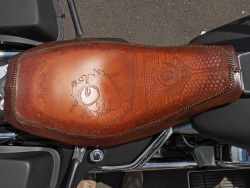
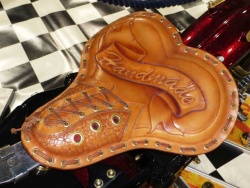









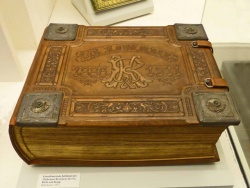
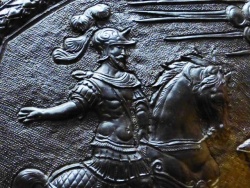
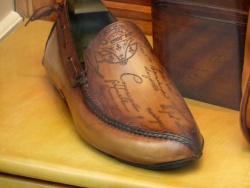
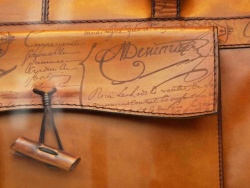
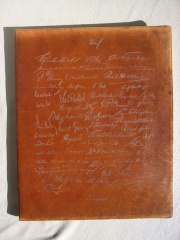

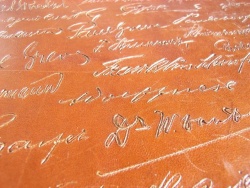
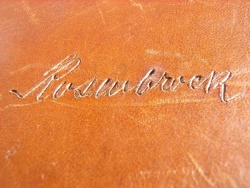
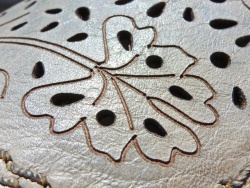
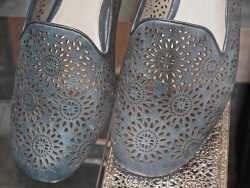

 a kotori web solution
a kotori web solution